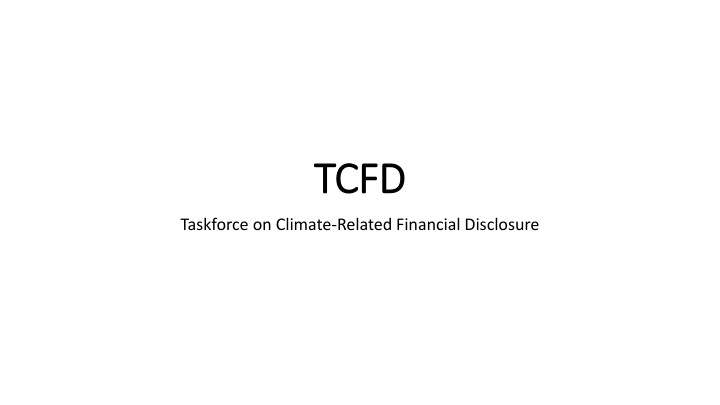
Climate-Related Financial Disclosures and Implications
The Task Force on Climate-related Financial Disclosures (TCFD) is developing voluntary climate-related financial risk disclosures to help companies provide information to investors and stakeholders. Accurate disclosure of risks is crucial for informed capital allocation decisions in financial markets. Climate change poses significant risks that require immediate attention, despite challenges in estimating their exact impact. Organizations need to consider these implications in their decision-making processes to avoid misallocation of capital.
Download Presentation

Please find below an Image/Link to download the presentation.
The content on the website is provided AS IS for your information and personal use only. It may not be sold, licensed, or shared on other websites without obtaining consent from the author. If you encounter any issues during the download, it is possible that the publisher has removed the file from their server.
You are allowed to download the files provided on this website for personal or commercial use, subject to the condition that they are used lawfully. All files are the property of their respective owners.
The content on the website is provided AS IS for your information and personal use only. It may not be sold, licensed, or shared on other websites without obtaining consent from the author.
E N D
Presentation Transcript
TCFD TCFD Taskforce on Climate-Related Financial Disclosure
MISSION MISSION The Task Force on Climate-related Financial Disclosures will develop voluntary, consistent climate-related financial risk disclosures for use by companies in providing information to investors, lenders, insurers, and other stakeholders TCFD will consider the physical, liability and transition risks associated with climate change and what constitutes effective financial disclosures across industries The work and recommendations of TCFD will help companies understand what financial markets want from disclosure in order to measure and respond to climate change risks, and encourage firms to align their disclosures with investors needs
MARKETS & TRANSPARENCY MARKETS & TRANSPARENCY One of the essential functions of financial markets is to price risk to support informed, efficient capital-allocation decisions Accurate and timely disclosure of current and past operating and financial results is fundamental to this function, but it is increasingly important to understand the governance and risk management context in which financial results are achieved The financial crisis of 2007-2008 was an important reminder of the repercussions that weak corporate governance and risk management practices can have on asset values This has resulted in increased demand for transparency from organizations on their governance structures, strategies, and risk management practices. Without the right information, investors and others may incorrectly price or value assets, leading to a misallocation of capital
IMPLICATIONS OF CLIMATE CHANGE IMPLICATIONS OF CLIMATE CHANGE One of the most significant, and perhaps most misunderstood, risks that organizations face today relates to climate change While it is widely recognized that continued emission of greenhouse gases will cause further warming of the planet and this warming could lead to damaging economic and social consequences, the exact timing and severity of physical effects are difficult to estimate The large-scale and long-term nature of the problem makes it uniquely challenging, especially in the context of economic decision making. Accordingly, many organizations incorrectly perceive the implications of climate change to be long term and, therefore, not necessarily relevant to decisions made today
IMPLICATIONS OF CLIMATE CHANGE IMPLICATIONS OF CLIMATE CHANGE For many investors, climate change poses significant financial challenges and opportunities, now and in the future. The expected transition to a lower-carbon economy is estimated to require around $1 trillion of investments a year for the foreseeable future, generating new investment opportunities At the same time, the risk-return profile of organizations exposed to climate- related risks may change significantly as such organizations may be more affected by physical impacts of climate change, climate policy, and new technologies Both investors and the organizations in which they invest, therefore, should consider their longer-term strategies and most efficient allocation of capital. Organizations that invest in activities that may not be viable in the longer term may be less resilient to the transition to a lower-carbon economy; and their investors will likely experience lower returns. Compounding the effect on longer- term returns is the risk that present valuations do not adequately factor in climate-related risks because of insufficient information
CORE ELEMENTS CORE ELEMENTS
